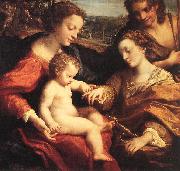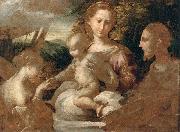
|
Correggio
|
|||
|
|
|||
| Italian 1489-1534 Correggio Locations Italian painter and draughtsman. Apart from his Venetian contemporaries, he was the most important northern Italian painter of the first half of the 16th century. His best-known works are the illusionistic frescoes in the domes of S Giovanni Evangelista and the cathedral in Parma, where he worked from 1520 to 1530. The combination of technical virtuosity and dramatic excitement in these works ensured their importance for later generations of artists. His altarpieces of the same period are equally original and ally intimacy of feeling with an ecstatic quality that seems to anticipate the Baroque. In his paintings of mythological subjects, especially those executed after his return to Correggio around 1530, he created images whose sensuality and abandon have been seen as foreshadowing the Rococo. Vasari wrote that Correggio was timid and virtuous, that family responsibilities made him miserly and that he died from a fever after walking in the sun. He left no letters and, apart from Vasari account, nothing is known of his character or personality beyond what can be deduced from his works. The story that he owned a manuscript of Bonaventura Berlinghieri Geographia, as well as his use of a latinized form of Allegri (Laetus), and his naming of his son after the humanist Pomponius Laetus, all suggest that he was an educated man by the standards of painters in this period. The intelligence of his paintings supports this claim. Relatively unknown in his lifetime, Correggio was to have an enormous posthumous reputation. He was revered by Federico Barocci and the Carracci, and throughout the 17th and 18th centuries his reputation rivalled that of Raphael. | |||
|
|
|||
|
The Mystic Marriage of St Catherine new1/Calvaert, Denys1.jpg Painting ID:: 9843 |
c. 1520 Wood, 105 x 102 cm Mus??e du Louvre, Paris | ||
|
|
|||
|
ALTICHIERO da Zevio
|
|||
|
|
|||
| Italian Gothic Era Painter, ca.1330-1390 Altichiero da Verona (also called Aldighieri da Zevio; c. 1330 ?C c. 1390) was an Italian painter of the Gothic style. A follower of Giotto, Altichiero is credited with founding the Veronese school. He worked in Verona and Padua ?? works by him survive in the church of Sant'Anastasia in Verona and in the basilica of Sant'Antonio and the Oratorio di San Giorgio in Padua (where the credit for the work has been generally shared with Jacopo d'Avanzi, about whom little is known). Altichiero was probably born somewhere near Zevio. He became an important member of the della Scala's household, and around 1364 painted a series of frescoes based upon Flavius Josephus's The Wars of the Jews at the della Scala palace of Sala del Podest??. There are frescoes by him in the Basilica of Saint Anthony of Padua. In conjunction with D'Avanzo Veronese, he frescoed the chapel of St. James for which he was paid 792 ducats. The first seven frescoes on the life of St. James the Elder were by Altichiero. | |||
|
|
|||
|
The Mystic Marriage of St Catherine new9/ALTICHIERO da Zevio-453634.jpg Painting ID:: 33336 |
mk86 c.1410-1420 Tempera on wood 75x58cm Siena,Pinacoteca Nazionale | ||
|
|
|||
|
Gerard David
|
|||
|
|
|||
| b.c. 1460, Oudewater, Neth. d.Aug. 13, 1523, Bruges Flemish Gerard David Locations Netherlandish painter. He is known as the last of the Flemish Primitives. Although born in the northern Netherlands, he moved to Bruges as a young man, and most of his work expresses the impassive, unmannered, microscopically realistic approach peculiar to south Netherlandish art in the time of Jan van Eyck. David was skilled at synthesizing the art of several important south Netherlandish predecessors, adapting, for instance, the compositions of van Eyck and the technique of Hugo van der Goes. He was also influenced by Hans Memling, whose example led him to refine and polish his cruder northern Netherlandish style and to adopt the popular theme of the Virgin and Child enthroned. | |||
|
|
|||
|
The Mystic Marriage of St Catherine new9/Gerard David-394877.jpg Painting ID:: 33531 |
mk86 c.1505-1510 Oil tempera on wood 106x144cm London,National Gallery | ||
|
|
|||
|
CEREZO, Mateo
|
|||
|
|
|||
| Spanish painter (b. ca. 1626, Burgos, d. 1666, Madrid) | |||
|
|
|||
|
The Mystic Marriage of St Catherine new21/CEREZO, Mateo-824883.jpg Painting ID:: 62368 |
207 x 163 cm Museo del Prado, Madrid After his return to Madrid around 1660, Cerezo's development was rapid as a religious painter and as one of the most appealing still-life artist of the period. These abilities are already evident in his Mystic Marriage of St Catherine, where the bright colours, sparkling textures, and harmonious composition show his precocious | ||
|
|
|||
|
PARMIGIANINO
|
|||
|
|
|||
| Italian Mannerist Painter, 1503-1540 Italian painter, draughtsman and printmaker. Beginning a career that was to last only two decades, he moved from precocious success in the shadow of Correggio in Parma to be hailed in the Rome of Clement VII as Raphael reborn. There he executed few large-scale works but was introduced to printmaking. After the Sack of Rome in 1527, he returned to northern Italy, where in his final decade he created some of his most markedly Mannerist works. Equally gifted as a painter of small panels and large-scale frescoes both sacred and profane, he was also one of the most penetrating portrait painters of his age. | |||
|
|
|||
|
The Mystic Marriage of St Catherine new25/PARMIGIANINO-876459.jpg Painting ID:: 84597 |
Date ca. 1527(1527) Medium Oil on wood Dimensions Height: 21 cm (8.3 in). Width: 27 cm (10.6 in). cjr | ||
|
|
|||
|
Also Buy::. For Following Paintings / Artists / Products, Please Use Our Search Online: |












